 Publisher Board & Dice is back with another look at early-civilization strategy, this time by way of Mesoamerica and the Mexican state of Oaxaca. True to form, Zapotec bears hallmarks of some of the publisher’s previous output: era-specific resource production, technology upgrades, solo play, and centralized pyramids. But in a stunning turn of events, we’re provided only one track to traverse.
Publisher Board & Dice is back with another look at early-civilization strategy, this time by way of Mesoamerica and the Mexican state of Oaxaca. True to form, Zapotec bears hallmarks of some of the publisher’s previous output: era-specific resource production, technology upgrades, solo play, and centralized pyramids. But in a stunning turn of events, we’re provided only one track to traverse.
Designer Fabio Lopiano, of Calimala and Merv fame, showcases a midweight area majority hand management system that’s filled with temples, villages, and plenty of corn. Let’s dig into the review field and plant some seeds to see if this is a game that will grow beyond the depths of board game obscurity.
Gameplay Overview:
Zapotec’s board is filled with three regions dedicated to specific deities (Etla, Ocotlan, and Mitla) as their civilization was polytheistic. In each of these regions, there are three areas made up of plains, mountains, and forests. Each of these terrains contains a different distribution of building types (temple, village, or cornfield). How a cornfield is a considered a building is not up for discussion. The remainder of the board is filled with space for pyramids, trade tiles, and the sacrifice track.
In each of the five rounds, players select a card from their hand to play simultaneously. These cards feature a resource (brick, wood, or stone), a property related to the regions on the board, as well as a number. The resource icon indicates the income options available this round, whereas the property dictates where players can build houses for area majority influence. Finally, whoever has played the lowest number on their card is the starting player, followed by the next lowest number.
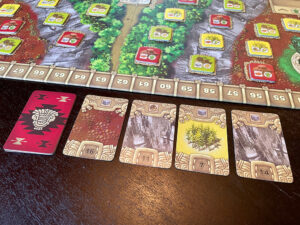
During a turn, players begin by collecting income from all icons present in either the row or column indicated by the resource. As players build houses, they gain building tiles to add to their individual player board that can be placed in any available space. These tiles feature two icons and, as such, produce those two icons when triggered. Temples provide a priest resource, villages a gold resource, and cornfields… you get the idea. As the game progresses, income steadily increases based on how many building tiles are present in the activated row or column.
With income out of the way, the active player takes any number of actions based on their available resources. Actions include buying a trade tile (technology) for gold, building a level of a pyramid that acts as a scoring filter at endgame, taking a ritual action that allows players to spend a priest and gold to be represented on endgame scoring cards, or the sacrifice action which allows players to spend up to five corn resources (and a priest) to move up the sacrifice track for bonuses.
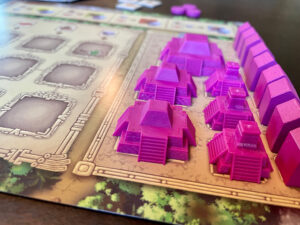
The final action is the construction step, which must be taken after the capital actions listed above. During construction, players can build houses onto the property type listed in the middle of their active card. Houses have a specific resource cost depending on which type you’re building. Players can also construct a one-time special palace house which counts as double points for all scoring purposes.
Once all actions are taken, players must choose a card from a face-up display to add to their hand. After players have finished the round, the final card not taken from the display moves onto the main board. The property listed on this card becomes an end-round bonus scoring opportunity for all houses represented there. All action cards played during the round then get added to the face-up display, with one additional card from the round track pile.
Final scoring awards points to those who traveled furthest up the sacrifice track, have a presence on ritual cards, as well as from the levels of the pyramid they built.
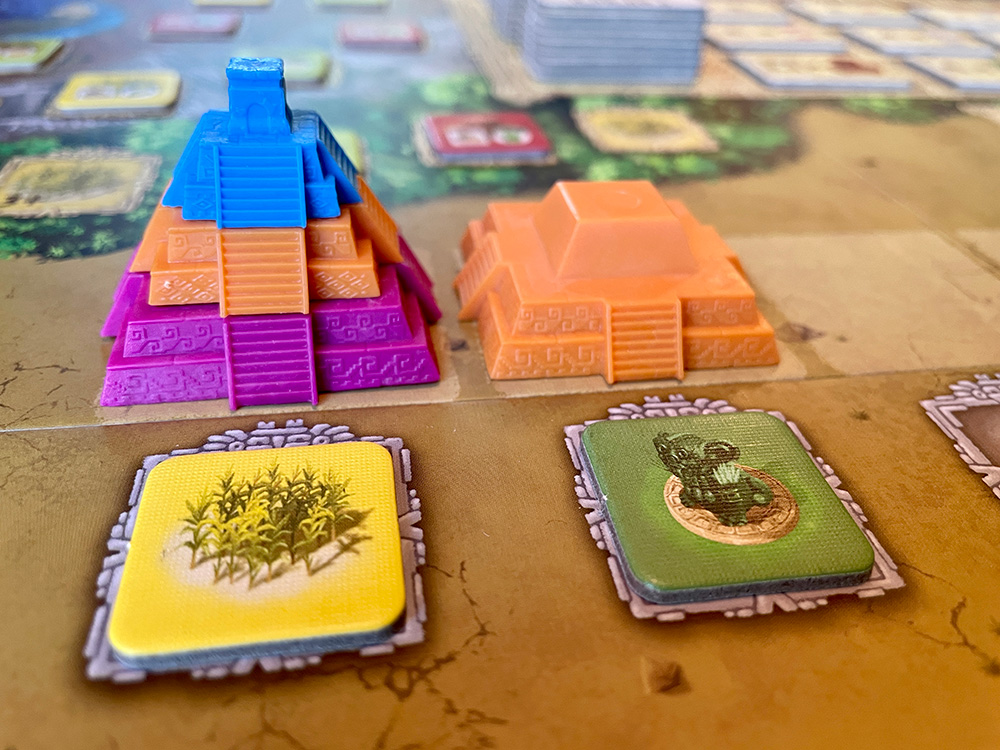
Game Experience:
It is not explicitly clear in the overview that the choice of which card to play each round is crucial. It determines player order, income, and where buildings can be built. Pair that with the fact that you have no idea which cards others are playing, and there’s a lot of up-front decision-making with imperfect information. This hand management space is incredibly tense, and while it only lasts for a moment during play, it’s the true star of Zapotec.
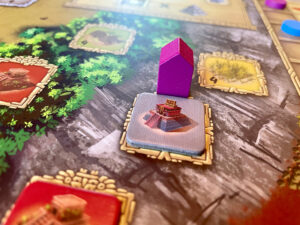
Another area that is well-considered is the mini-game of where to place your building tiles to produce the best income from your corresponding hand of cards. The balance of filling up rows/columns to produce more income, finding the right types of building tiles to add to the tableau, as well as considering ritual card scoring, all create a crunchy decision space for a relatively lighter medium-weight game.
Zapotec provides plenty of opportunity for big turns too. Players can make their income combo with tech tiles and sacrifice track bonuses to keep their building engine running strong. As long as other players don’t take the building spaces you were eyeing by going earlier in turn order.
And building spaces are enticing when everyone can see the bonus scoring card on display, which provides ample points for houses on certain properties. As such there’s another balancing act between when to get houses onto the board and when to pivot to build a pyramid level to increase endgame scoring opportunities. With only five rounds, every decision is crucial, and turn order matters.
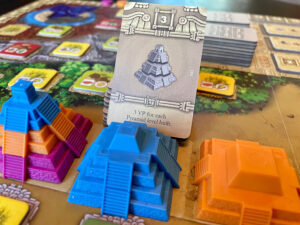
Speaking of five rounds, Zapotec has such a restrictive structure that it almost feels like it isn’t long enough. It’s a game where players must find the right path to points by focusing on specifics, but it can feel like your engine is just getting to where you want it when the final turn takes place. This is highlighted by the choice of pushing hard for pyramids vs. houses vs. sacrifice. All provide points, and while I can’t quite comment on the balance between these options, both the pyramid and sacrifice track don’t feel as integrated as the houses.
We found that most of our plays had heavy pyramid or sacrifice track pushes to try to negate points being scored by others in those areas. Considering that players can only add presence to a ritual card per level of pyramid they’ve built, this area draws more focus, but the sacrifice track also features many opportunities. The biggest benefit is a discount on trade tiles.
Yet again I’m back to game length. Zapotec accomplishes what it sets out to do. Make a euro-style strategy game that pays homage to its heavier brethren but decreases the playtime to under an hour. It can’t be faulted for trying to attempt a lighter route, but at the same time, it loses something in the process. And while most of these types of games minimize theme, this attempt is mechanism-forward and eschews theme.
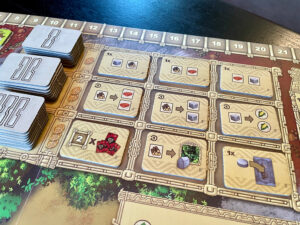
The rulebook is clear and concise. Component quality is sub-par, probably to keep the price low. The plastic pyramid levels do stack, but contrast with everything else. Player boards are thin sheets, resource tokens are cardboard, and some of the iconography on the ritual cards is atrocious. And the illustrations, by Aleksander Zawada, try to connect to the Mesoamerican culture, but are awash in a sea of beige and yellow and green. Wait, was it corn all along?
Final Thoughts:
There’s something to be said about a lighter mid-weight design coming out of the Board & Dice camp. Everything here is toned down, plays at a brisk pace, and features a decision space that has texture. Like a crunchy bite into that corn on the cob you’ve been thinking about since the intro. It doesn’t do enough to elevate it amongst its weight class, but it may provide a fun experience for those seeking something that plays quickly. We enjoyed this most at three players. Two didn’t provide enough area influence restrictions, whereas four pushed over an hour and turns overstayed their welcome. It does attempt to scale for each count, but it’s clear this is best at three.
Final Score: 3.5 stars – No matter how much corn is sacrificed, Zapotec can only rise up so far on the Board & Dice must-buy track.
 Hits:
Hits:
• Card selection strategy
• Growing income puzzle
• End of turn bonus scoring
Misses:
• One round too short
• Turns can overstay their welcome
• Uninspiring component decisions





















